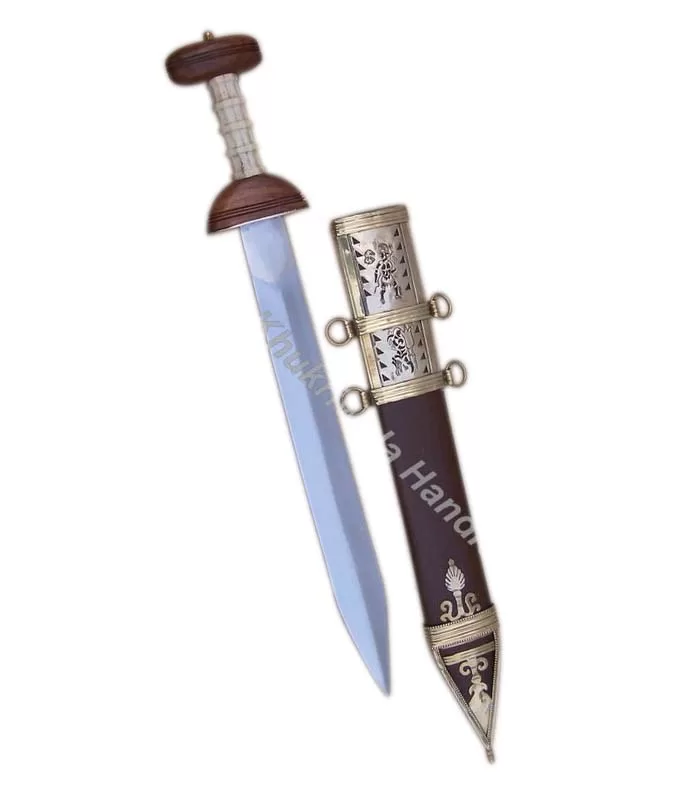SD33 Roman Gladius
19 Inches High Carbon Steel Half Tang Bolt Welded Blade. Hand Polished. Bone Handle with Wooden Nut & Pomel. Wooden Scabbard Artificial Leather Covered with Brass Parts on both the ends.
| Brand | |
|---|---|
| Color | , , |
| Size |
19 inches blade |
Category: Medieval Swords
Description
The SD33 Roman Gladius: A Weapon of Historical Significance
The SD33 Roman Gladius is a crucial weapon in ancient military history. This short sword, commonly used by Roman legionaries, showcases an impressive combination of design and effectiveness. By examining its features, historical context, and cultural impact, we can understand its significant role in Roman warfare.
Design and Features
Typically, the SD33 gladius measures between 18 and 24 inches in blade length. The double-edged design enables both cutting and thrusting, making it a versatile weapon in battle. Crafted from durable iron, the gladius is built to withstand intense combat. The hilt is often wrapped in leather, ensuring a secure grip for soldiers. This ergonomic design allows for comfortable handling, even in chaotic situations. Additionally, the pointed tip enhances its ability to deliver precise strikes, making it effective in close-quarters combat.
Historical Context
During the Roman Republic and Empire, the gladius became a symbol of military power. It was primarily wielded by legionaries, who relied on its effectiveness during various military campaigns. As Rome expanded its territories, the gladius played a vital role in numerous battles. Historians note that its design significantly influenced Roman military strategy. The gladius allowed soldiers to engage quickly and decisively, giving them an advantage in crowded formations.
Combat Techniques
In battle, the SD33 gladius was often used in conjunction with a shield. This combination provided both defensive and offensive capabilities. Soldiers trained extensively to master effective thrusting techniques, which became essential in close combat scenarios. The shorter length of the gladius facilitated quick and lethal strikes, often catching enemies off guard. Rigorous training ensured that Roman soldiers could exploit the gladius’s strengths, making them formidable opponents on the battlefield.
Cultural Impact
The SD33 gladius also holds cultural significance beyond its battlefield application. It is depicted in various forms of art, literature, and modern media, symbolizing bravery and honor. Many contemporary representations of Roman soldiers prominently feature the gladius, highlighting its enduring legacy. By studying this iconic weapon, we gain valuable insights into the values and ideals of ancient Roman society. The gladius embodies not only a tool of warfare but also a representation of Roman identity and power.
Conclusion
In conclusion, the SD33 Roman Gladius is a remarkable weapon with a rich historical legacy. Its effective design, combat applications, and cultural significance illustrate its importance in ancient Rome. Understanding the gladius enhances our appreciation of Roman military history and its broader influence on civilization. The gladius shaped military tactics and left a lasting mark on perceptions of strength and valor throughout history. Its enduring presence symbolizes the might of the Roman Empire and its impact on the world.
Reviews (0)
Be the first to review “SD33 Roman Gladius” Cancel reply
About brand
We deals in khukries, daggers, knives, swords, medieval helmets, axes, shields, walking sticks, bugles, nautical, chain mail, horn items, etc.
Shipping & Delivery


Khukriwala Handicraft
We deals in Khukries, Daggers, Knives, Swords, Axes, handcuffs, Medieval helmets, Shields, Walking sticks, Bugles, Nautical, chain mails, horns and bone items, Leather items, miscellaneous items etc. We also do custom work.
Our Vision
- Our Products are handmade by the team of dedicated artisans and craftsmen who are richly experienced in their fields and products are thoroughly inspected by our quality control personnel’s at every stage of production.
- Each item is carefully and elegantly handmade with traditional skill handed down to us from centuries of experience and reliability.
- Our items include show pieces of historical & ancient figures reproduce to their originality and shape.
All our items are blunt edge. Handmade hand polished. Need to apply on blade to avoid rust. Items manufactured as manufactured in olden days. Not Novelty.



Reviews
There are no reviews yet.